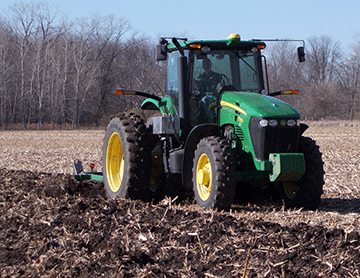By Alejandro Plastina
Performing custom work can be an additional source of income for farm operators around the state. For others, custom work is a full-time career. When labor is available, and another party has equipment, renting equipment for a short term is also a common practice. While only a small portion of Iowa farmland is 100 percent custom farmed, many farm operations rent equipment or hire out for one or two tasks that need to be completed on their farm each year.

The 2017 Iowa Farm Custom Rate Survey canvassed 441 farmers, custom operators and farm managers from the state, putting together a guide for pricing custom machine work. Of those receiving the survey, 152 usable responses were received from Iowa farmers, custom operators and farm managers. Twenty-one percent of the respondents perform custom work, 13 percent hire work done, 41 percent indicated doing both, 1 percent indicated doing none and 25 percent did not indicate whether they perform or hire custom work.
The publication, which can be found online at the Iowa State University Extension and Outreach Store as FM 1698 or on the Ag Decision Maker website as Information File A3-10, provides rates for custom work in the following categories: tillage, planting, drilling, seeding, fertilizer application, harvesting, drying and hauling grain, harvesting forages, complete custom farming, labor and both bin and machine rental. All rates include fuel, repairs, depreciation, interest, labor and all other machinery costs for the tractor and implement unless otherwise noted.
The average rate and range for each machine work function were compiled into the survey as usual, as well as the median charge and number of responses for each category. For the survey, the average is calculated as the simple average of all responses. The median is the response that splits all the ordered responses (from smallest to largest) in half.
The survey found there was an 8.5 percent price increase across all surveyed categories. When the categories with the 5 percent highest and lowest change were removed, the average increase in rate became 2.1 percent.
“After an overall decline in rates in 2016, the slight rate increases in the 2017 survey are similar to a trend observed from 2012-2015,” said Alejandro Plastina, assistant professor and extension economist with ISU Extension and Outreach. “We appreciate the respondents to the survey, as the information available in the Custom Rate Survey is only possible due to their responses provided each year.”
The reported rates are expected to be charged or paid in 2017, including fuel and labor. The average price for diesel fuel was assumed to be $2.15 per gallon. The values presented in the survey are intended only as a guide. There are many reasons the rate charged in a particular situation should be above or below the average. These include the timeliness with which operations are performed, quality and special features of the machine, operator skill, size and shape of fields, number of acres contracted and the condition of the crop for harvesting. The availability of custom operators in a given area will also affect rates. Any custom rate should cover the cost of operating the farm machinery as well as the operator’s labor.
The Ag Decision Maker website offers a Decision Tool to help custom operators and other farmers estimate their own costs for specific machinery operations.
Source:.iastate.edu